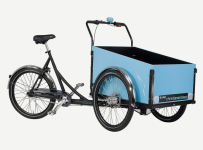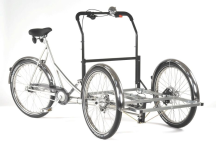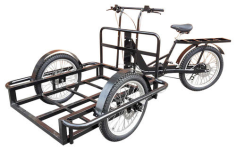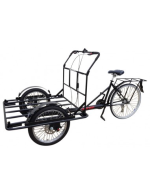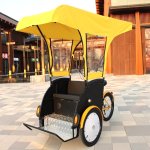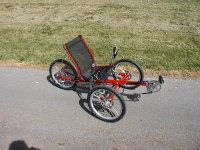Mossha150
10 mW
I’m looking for thoughts, suggestions and technical advice on the feasibility of building a custom (Christiania-type with two wheels in the front and one in the rear) vending etrike. I’m new to the forum and will do my best to explain what I’m trying to do in sufficient detail to garner constructive feedback and input. My technical knowledge of e-bikes is limited and so I apologize in advance if any information I provide or questions I ask sound a little ridiculous.
I’m trying to figure out how to build an awesome-looking etrike to sell cold and nitro brew along with other non-alcoholic beverages (maybe hot cocoa in the winter) on tap at local festivals and events here in Alaska. I’ve looked at the variety of manufactured vending trikes, however, they don’t quite meet my needs or desires.
My basic concept is to modify a steel frame fat bike to incorporate a chest freezer (converted to a refrigerated cooler), in which I can haul up to eight 5 gal kegs, a nitrogen tank and CO2 tank (if needed). Between the donor bike, modifications, chest freezer, kegs, LiFePO4 battery, rider, etc., I estimate the total weight would be upwards of 1,500 lbs. I’m not trying to build a tank but a fully functional unique mobile business.
If possible, I would like to use 26” fat bike wheels in the front and rear for something a little unique. For simplicity, I was looking at using Grin’s 8T slow wind All-Axle hub motors in the two front wheels, assuming I can make it work with direct drive hub motors. I would leave the rear drive train as stock (non-motorized) with the chain and cassette. I don’t need a lot of speed or distance, just a lot of torque I assume. I would plan to haul (trailer) the bike to the vicinity of the event and then pedal it the rest of the way into position.
I used Grin’s motor simulator and bounced the results off of Grin’s tech staff. While it appears the motors wouldn’t overheat, it’s unclear if they would be able to handle the massive load and if I would actually get much benefit from the motors. The Grin’s tech rep’s concern is finding a wheel setup capable of supporting that much weight and he pointed me to this community for input, so here I am. I realize there are a lot of details to figure out, but it seems the wheels and brakes are maybe the starting point of determining if I can make this work. So this brings me to my first few questions.
Can you use a 48V LiFePO4 battery for an ebike? Are there any major issues or concerns with going this route? I thought a larger capacity battery would allow me to be self-sufficient all day and then recharge at home overnight.
Lastly (for now), could I pull a trailer with this etrike? If possible, I would like to have the option of pulling a trailer with another chest freezer to have an ice cream cart in tow and sell floats as well with the root beer on tap. The trailer would also have 26” fat tire wheels and another LiFePO4 battery (if needed) to run the freezer. If this would work, could you use hub motors in the trailer wheels for more power and help push the etrike?
I know it’s a lot of questions and I would appreciate any thoughts or suggestions. I would really Iike to figure out how to build a fun and unique etrike to help bring some joy to folks.
I’m trying to figure out how to build an awesome-looking etrike to sell cold and nitro brew along with other non-alcoholic beverages (maybe hot cocoa in the winter) on tap at local festivals and events here in Alaska. I’ve looked at the variety of manufactured vending trikes, however, they don’t quite meet my needs or desires.
My basic concept is to modify a steel frame fat bike to incorporate a chest freezer (converted to a refrigerated cooler), in which I can haul up to eight 5 gal kegs, a nitrogen tank and CO2 tank (if needed). Between the donor bike, modifications, chest freezer, kegs, LiFePO4 battery, rider, etc., I estimate the total weight would be upwards of 1,500 lbs. I’m not trying to build a tank but a fully functional unique mobile business.
If possible, I would like to use 26” fat bike wheels in the front and rear for something a little unique. For simplicity, I was looking at using Grin’s 8T slow wind All-Axle hub motors in the two front wheels, assuming I can make it work with direct drive hub motors. I would leave the rear drive train as stock (non-motorized) with the chain and cassette. I don’t need a lot of speed or distance, just a lot of torque I assume. I would plan to haul (trailer) the bike to the vicinity of the event and then pedal it the rest of the way into position.
I used Grin’s motor simulator and bounced the results off of Grin’s tech staff. While it appears the motors wouldn’t overheat, it’s unclear if they would be able to handle the massive load and if I would actually get much benefit from the motors. The Grin’s tech rep’s concern is finding a wheel setup capable of supporting that much weight and he pointed me to this community for input, so here I am. I realize there are a lot of details to figure out, but it seems the wheels and brakes are maybe the starting point of determining if I can make this work. So this brings me to my first few questions.
- Is it even in the realm of possibility to find a fat tire rim and spoke combination that is capable of supporting 500-600 lbs per wheel?
- If so, would an aluminum rim or carbon rim be better? I looked at Nextie’s double wall carbon rims, which are rated to support 440 lbs (200 KG) and it appears in their description of their Wild Dragon rim it may be able to support more than that, but they can’t say it’s rated for that load.
- Would a wider fat tire rim be stronger than a narrower rim? If so, would you recommend a 65, 80, 90,100 mm or even wider rim?
- What fat tires would I need to use? Can you insert foam or anything else inside the tires to increase their load carrying capacity?
- If I have the option, would there be a benefit of using 20” fat tire wheels for the front two instead of 26”?
- If there is a fat tire rim that would work, what gauge spokes would be recommended?
- If a fat bike wheel won’t work, could you use a moped or motorcycle rims and still use Grin’s All-Axle hub motors?
- Can I make this work with direct drive hub motors? Or do I need to find another solution?
- If I can find bike wheels that will work, what is recommended for braking? Are bicycle disc brakes up to the task? Do I need to consider adapting motorcycle rotors. What about using regen brakes or ABS?
Can you use a 48V LiFePO4 battery for an ebike? Are there any major issues or concerns with going this route? I thought a larger capacity battery would allow me to be self-sufficient all day and then recharge at home overnight.
Lastly (for now), could I pull a trailer with this etrike? If possible, I would like to have the option of pulling a trailer with another chest freezer to have an ice cream cart in tow and sell floats as well with the root beer on tap. The trailer would also have 26” fat tire wheels and another LiFePO4 battery (if needed) to run the freezer. If this would work, could you use hub motors in the trailer wheels for more power and help push the etrike?
I know it’s a lot of questions and I would appreciate any thoughts or suggestions. I would really Iike to figure out how to build a fun and unique etrike to help bring some joy to folks.


